Tooth Temple (Dalada Maligava)

Temple of the Tooth
Dalada Maligava (the Temple of the Tooth), repository of a sacred Buddhist relic said to be a tooth of the Buddha, is here, and the University of Peradeniya (1942) is nearby. Kandy was the capital of a Sinhalese kingdom from 1592 to 1815, when it became one of the last sections of the island to be annexed by the British as part of colonial Ceylon (now Sri Lanka). Population (1990 estimate) 104,000.
Arial View of Maligawa
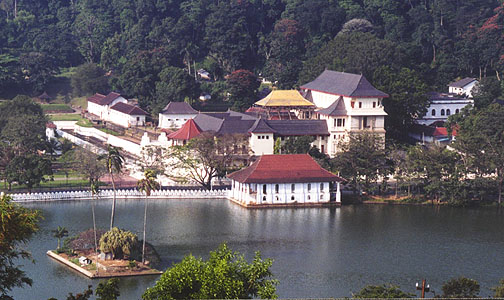
Temple entrance
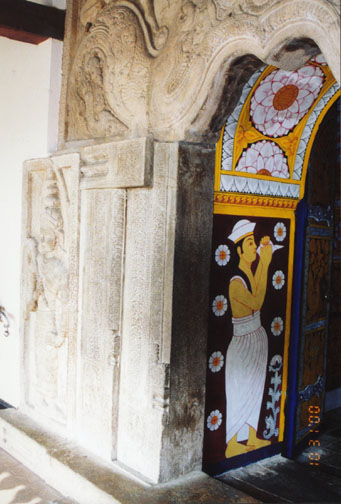
hallway
(redecorated since the bomb damage in 1998)
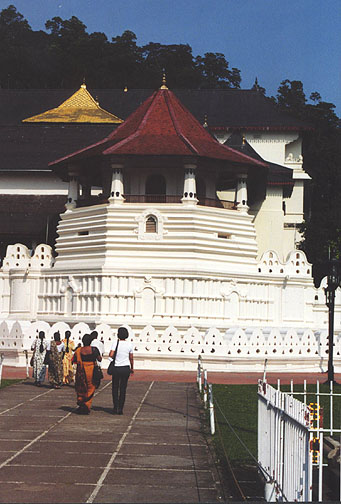
Buddha statue

doors

tells the story of the tooth being rescued from the
Sandalwood cremation of Buddha

presentation of the tooth to the temple for safekeeping
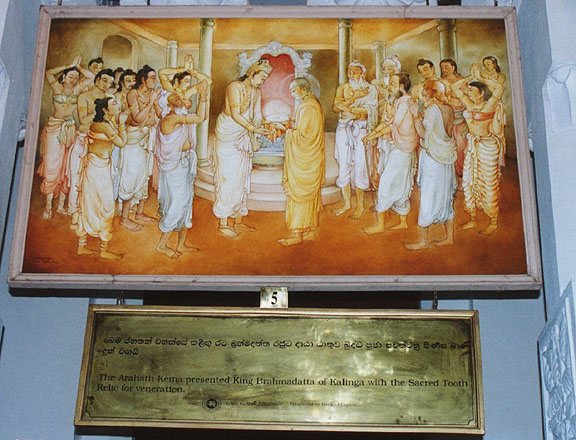 the tooth was displayed to save the country from draught
the tooth was displayed to save the country from draught
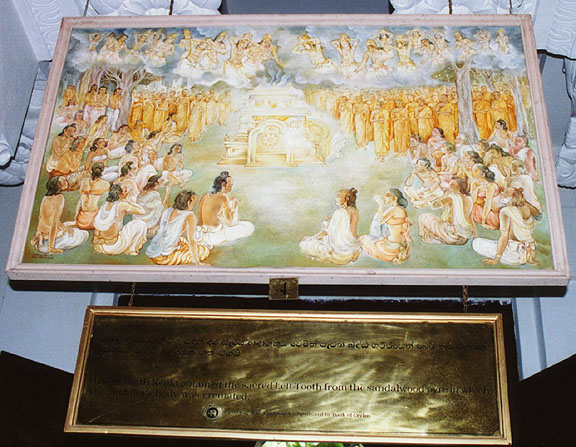
the altar where the tooth is held

stupa with processional standards

Anglican church location next to temple grounds
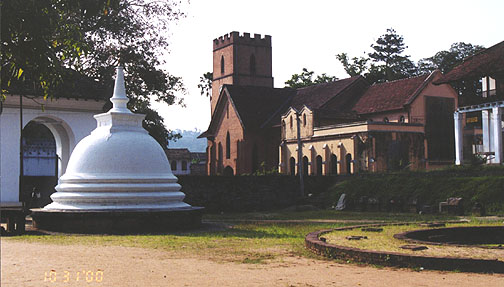
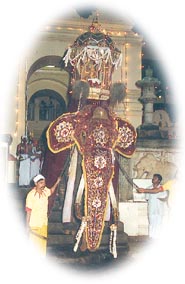
Although the Esala perahera in Kandy, as we see it today, dates back to the period of King Kirti Sri Rajasinha (1747-1780), there have been throughout history of the island, processions and festivals of great magnitude, which could be considered as the precursors of the present perahera. The early festivals connected with the 'Dantha Dhatu' (Tooth Relic of the Buddha) which were performed independently of festivals of gods seem to have taken place on the occasion of its annual removal temporarily from the Maligawa to the Abhayagiri vihara as required by King Sri Meghavanna (325-377), during whose reign the sacred Relic was brought to Sri Lanka, by Prince Danta and Princess Hemamala, from Kalinga (now Orissa).
Before 1775, the Esala perahera in Kandy was exclusively held to entreat and implore the four guardian deities of the island, viz: Natha, Vishnu, Kataragama and Pattini. This is confirmed by Robert Knox, who was a captive in the Kandyan provinces for twenty years (1659-1679). He says" "That they (the Sinhalese) may therefore honour these Gods, and procure their aid and assistance, they do yearly in the Month of July, at a New Moon, observe a solemn feast and general meeting called Perahar."
Buddhists, in principle, do not totally repudiate polytheism, the concept of divine worship, but pay their benefactions to the divine, although they consider them completely subordinate in importance to the Buddha. Therefore, the deities too receive the reverence and honour of the Buddhists. The worship of Gods and other divinities became popular among the Buddhists, specially during the period when Dravidian kings from Malabar in South India were ruling the country for 76 years (1739-1815). It was during this period that the Pattini cult took deep root in the soil of Sri Lanka, and Pattini became the guardian goddess replacing God Saman (the tutelary deity of Sri Pada).
Four Devales
It is of interest to know how the Dalada perahera came to be merged with the four devale peraheras. It happened this way. When bhikkus from Siam (now Thailand), headed by Pra Upali Maha Thera alias Buddhadhamma Upali came to Sri Lanka in 1775, in the Dutch vessels Oscarbel, to restore the defunct 'Upasampada' (the highest ordination qualifying a bhikku), their arrival coincided with the Esala festival that was being held in Kandy at the time to appease the four guardian deities, beseeching divine protection for the king, the country and the people.
When the Siamese (Thai) bhikku heard the noise of the jingalls (large swivel muskets of Indian origin), they surprisingly inquired from the king what the noise was about and the reason for all that unaccustomed practice. When the king explained to them that preparations were under way for celebrating the Esala festival in honour of the guardian deities of the island, they took umbrage at his words and expressed their sole disapproval and dissatisfaction for giving preferential treatment to Hindu practices in a country where Buddhism was the established religion. They expressed their deeper concern when they became aware that Hinduism has gradually triumphed over Buddhism under the patronage of the Dravidian kings who were Hindus.

A spectacular performance by Kandyan dancers
The king using his wits and in order to appease the bhikkus, assured them that the perahera was mainly intended to glorify the Sacred Tooth Relic of the Buddha. In order to convince them that it was so, the king proclaimed that the Relic too should be taken in the perahera and it should go foremost of the devale peraheras. This procedure still continues. At the same time, the king dedicated his own 'howdah' (ranhilige), which he used when riding on the back of the state elephant, to carry the Tooth Relic. It is said that since then no king used the ' ranhilige', and it was exclusively set apart to carry the reliquary. A 'ranhilige' was small gilded dome or cupola, supported by pillars about four feet high, well proportioned and handsomely built.
One may, perhaps, wonder why the perahera held in August is known as Esala perahera. Prior to 1915, it was held in July. The reason for the change is said to be that the holding of the perahera was banned in 1915, by the governor Sir Robert Chalmers (1913-1916), when the Sinhala-Muslim riots broke out with serious consequences. However, the governor William Manning (1918-1925), revived the situation and permitted holding of the perahera in 1919. Since it was held for the first time in August, the practice seems to have gained ground thereafter.
Kap Situweema
The perahera ritual complex beings with 'kap-situweema' (installation of the sanctified log), and ends with 'diya-kepeema' (water-cutting ritual), followed by the day-perahera. A few days before the new moon in August the 'kapuralas' of the four devales, go in search of a young jak tree (Artocarpus integrifolia), which has borne no fruit, and clear the ground beneath the tree. It is then fumigated with the smoke of burning resin and smeared with water mixed with sandalwood (Santalum album). Thereafter, flowers, betel and a lighted lamp are placed at the foot of the tree and the 'vruksha-devata' (tree-god), whose abode, perchance, it may be, is implored to leave. After this ritual, the tree is felled and the trunk is divided transversely into four equal parts and each piece is carried to the respective devales in order of preference, the Natha devale getting the first piece, Vishnu devale the second, kataragama devale the third and Pattini devale the fourth. Dr. John Davy, writing in 1821, says 'The felling of the tree is done by the wood-cutter of the Maha Vishnu devale, dressed in a clean white cloth and purified by washing himself with lemon juice.'
In the old days, the consecrated logs were installed on the ground, outside the devales, protected by a roof and covered and ornamented with palm-leaves, coconut, flowers and fruits. Today, they have diminished in size and are installed inside each devale where a special platform signifies its graceful position.
Return To Top Of Page
Home
Copyright © 2002 Warnaka.Tripod.com, All Rights Reserved.














